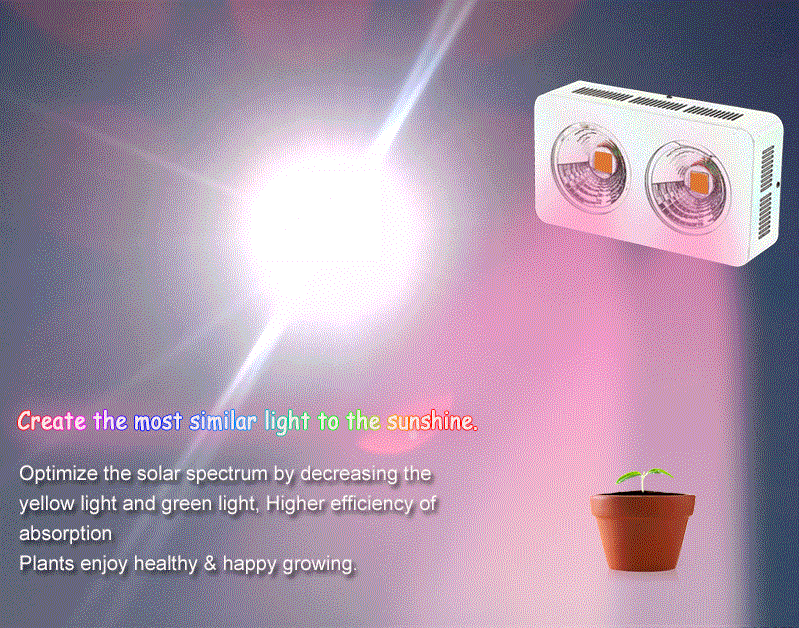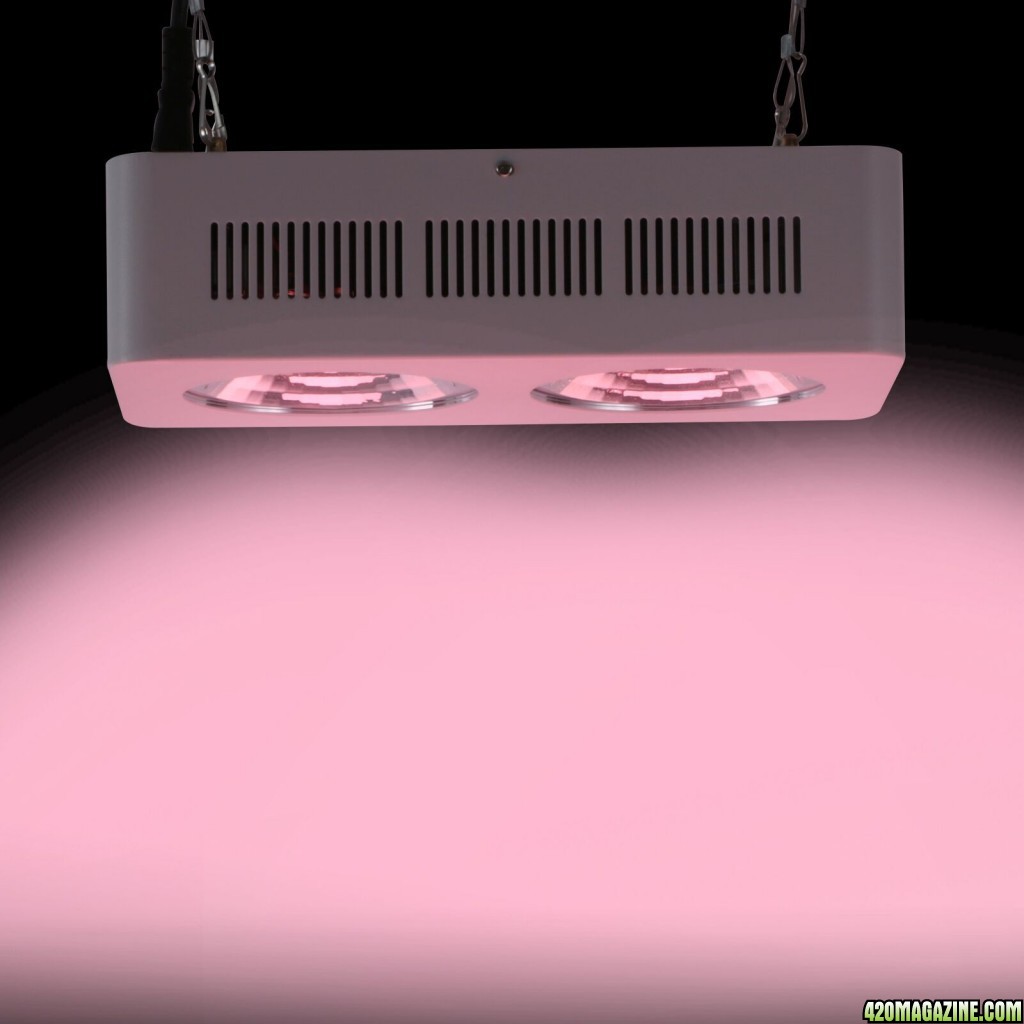Houyi Lighting
New Member
Hi, everybody in 420! Nice to be here today! As the lover of plant growing and the professional manufacturer of LEDs, we are sorry to be late here.
Nice to be here today! As the lover of plant growing and the professional manufacturer of LEDs, we are sorry to be late here.  As we know, 420 is a professional community forum of MJJ. It is happy to be one here. In the future, we will try our best to provide what we have and share what we know about LEDs. And we also hope that we can discuss together about plants growing and do help to our lovely plants!
As we know, 420 is a professional community forum of MJJ. It is happy to be one here. In the future, we will try our best to provide what we have and share what we know about LEDs. And we also hope that we can discuss together about plants growing and do help to our lovely plants! 
Today, I would like to introduce a NEW DESIGNED of LED grow light----- COB full spectrum led grow light, which provided by leading led light manufacturer with strong R&D team for over 6 years. Offered led grow light to people all over the world and gain millions of good feedback from end-users. If you have any idea or advice, pls comment!
which provided by leading led light manufacturer with strong R&D team for over 6 years. Offered led grow light to people all over the world and gain millions of good feedback from end-users. If you have any idea or advice, pls comment!
Firstly, what is COB? And what is our COB full spectrum led grow light?
COB means chip on board. It is a new technology of led grow lights, which can achieve the best light proportion by using the most improved color uniformity and luminous efficiency available.
And what is COB full spectrum led grow light?
Plants growing in the great outdoors have a number of benefits over plants that are grown inside. Primarily, they have the benefit of sunlight that offers the entire spectrum of visible light. In order to be able to provide your plants with everything they need, including light for both vegetative and flowering growth, you will need a full spectrum LED grow light.
HPS and fluorescent grow lamps have been used for many years when it comes to indoor growing. Many people still swear by them. There is a great advantage to having the very powerful light that they produce, which includes rays from all over the spectrum, although that comes at a cost. In exchange, people have turned to LED lighting, but many neglect to still make use of the full spectrum that is necessary for growing plants through a natural life cycle.
Many people make the mistake of only using one kind of LED grow light. That simply can’t provide your plants with what they need for both stages of growth. A full spectrum LED grow light, in comparison, will provide a wide range of blue, red, white, and ultraviolet light.
Moreover, as we all know, in the industry of chips, the most professional one is Cree. But they are expensive for us to have more of them. Now, our COB full spectrum led grow light can simulate the sunlight, which is good for all stages of plants growth. We use the high quality 3w Epileds chips and 90 degree reflective cup that means we can simulate the Cree. But our price is cheaper. And our light creates the most similar light to the sunshine for plants healthy & happy growth.


Details of the COB full spectrum led grow light (example: 400W).

Spectrum
A wide range of spectrum from a variety of colors is used to emit the best proper lighting for photosynthesis.

Under the continuous testing and upgrading, we finally find the best spectrum and color ratio for plants growth. The results proved that our lights are good for all stages of plants growth, specifically for the stages of flowering and fruiting.
The benefits of using COB full spectrum LED grow lights.
Power efficient
Traditional forms of lighting your indoor grow can be very powerful, but unfortunately they aren’t very power efficient. That is why COB full spectrum LED grow lights are preferred. They have the power to produce a great deal of light without having to draw much power. Doing this saves you money in the long run.
Long lifespan
When you use the best LED grow lights, you will have the chance to grow for years without having to replace your lighting system. Most LED lights are rated at somewhere between 50,000 and 100,000 hours of use. For comparison, many other grow lights tend to last for around 20,000 hours before needing to be replaced.
The colors of the spectrum
Natural sunlight features the entire spectrum of light. When constructing LED panels, the manufacturers use only certain kinds of LEDs that will provide a specific color in order to feed your plants what they need. Here we will look at the different colors, including what the best combination is for your grow operation.
Red. In contrast to blue light, Red LEDs in the 600-640 nm range will help encourage budding and flowering. Much like the way that blue light doesn’t help with flowering, too much red light will not help with vegetative growth, creating unhealthy plants.
Blue. Blue LED lights, in the mid-400nm range, are ideal for vegetative growth that creates tall, leafy plants. During the flowering and budding phase, though, blue light is not very helpful and it can cause bushy plants without many buds.
Hope everyone here could give us some support and advice. Thank you!

Warm welcome for the support and advice!
 Nice to be here today! As the lover of plant growing and the professional manufacturer of LEDs, we are sorry to be late here.
Nice to be here today! As the lover of plant growing and the professional manufacturer of LEDs, we are sorry to be late here.  As we know, 420 is a professional community forum of MJJ. It is happy to be one here. In the future, we will try our best to provide what we have and share what we know about LEDs. And we also hope that we can discuss together about plants growing and do help to our lovely plants!
As we know, 420 is a professional community forum of MJJ. It is happy to be one here. In the future, we will try our best to provide what we have and share what we know about LEDs. And we also hope that we can discuss together about plants growing and do help to our lovely plants! 
Today, I would like to introduce a NEW DESIGNED of LED grow light----- COB full spectrum led grow light,
 which provided by leading led light manufacturer with strong R&D team for over 6 years. Offered led grow light to people all over the world and gain millions of good feedback from end-users. If you have any idea or advice, pls comment!
which provided by leading led light manufacturer with strong R&D team for over 6 years. Offered led grow light to people all over the world and gain millions of good feedback from end-users. If you have any idea or advice, pls comment! Firstly, what is COB? And what is our COB full spectrum led grow light?
COB means chip on board. It is a new technology of led grow lights, which can achieve the best light proportion by using the most improved color uniformity and luminous efficiency available.
And what is COB full spectrum led grow light?
Plants growing in the great outdoors have a number of benefits over plants that are grown inside. Primarily, they have the benefit of sunlight that offers the entire spectrum of visible light. In order to be able to provide your plants with everything they need, including light for both vegetative and flowering growth, you will need a full spectrum LED grow light.
HPS and fluorescent grow lamps have been used for many years when it comes to indoor growing. Many people still swear by them. There is a great advantage to having the very powerful light that they produce, which includes rays from all over the spectrum, although that comes at a cost. In exchange, people have turned to LED lighting, but many neglect to still make use of the full spectrum that is necessary for growing plants through a natural life cycle.
Many people make the mistake of only using one kind of LED grow light. That simply can’t provide your plants with what they need for both stages of growth. A full spectrum LED grow light, in comparison, will provide a wide range of blue, red, white, and ultraviolet light.
Moreover, as we all know, in the industry of chips, the most professional one is Cree. But they are expensive for us to have more of them. Now, our COB full spectrum led grow light can simulate the sunlight, which is good for all stages of plants growth. We use the high quality 3w Epileds chips and 90 degree reflective cup that means we can simulate the Cree. But our price is cheaper. And our light creates the most similar light to the sunshine for plants healthy & happy growth.



Details of the COB full spectrum led grow light (example: 400W).

Spectrum
A wide range of spectrum from a variety of colors is used to emit the best proper lighting for photosynthesis.

Under the continuous testing and upgrading, we finally find the best spectrum and color ratio for plants growth. The results proved that our lights are good for all stages of plants growth, specifically for the stages of flowering and fruiting.

The benefits of using COB full spectrum LED grow lights.

Power efficient
Traditional forms of lighting your indoor grow can be very powerful, but unfortunately they aren’t very power efficient. That is why COB full spectrum LED grow lights are preferred. They have the power to produce a great deal of light without having to draw much power. Doing this saves you money in the long run.
Long lifespan
When you use the best LED grow lights, you will have the chance to grow for years without having to replace your lighting system. Most LED lights are rated at somewhere between 50,000 and 100,000 hours of use. For comparison, many other grow lights tend to last for around 20,000 hours before needing to be replaced.
The colors of the spectrum
Natural sunlight features the entire spectrum of light. When constructing LED panels, the manufacturers use only certain kinds of LEDs that will provide a specific color in order to feed your plants what they need. Here we will look at the different colors, including what the best combination is for your grow operation.
Red. In contrast to blue light, Red LEDs in the 600-640 nm range will help encourage budding and flowering. Much like the way that blue light doesn’t help with flowering, too much red light will not help with vegetative growth, creating unhealthy plants.
Blue. Blue LED lights, in the mid-400nm range, are ideal for vegetative growth that creates tall, leafy plants. During the flowering and budding phase, though, blue light is not very helpful and it can cause bushy plants without many buds.
Hope everyone here could give us some support and advice. Thank you!


Warm welcome for the support and advice!



